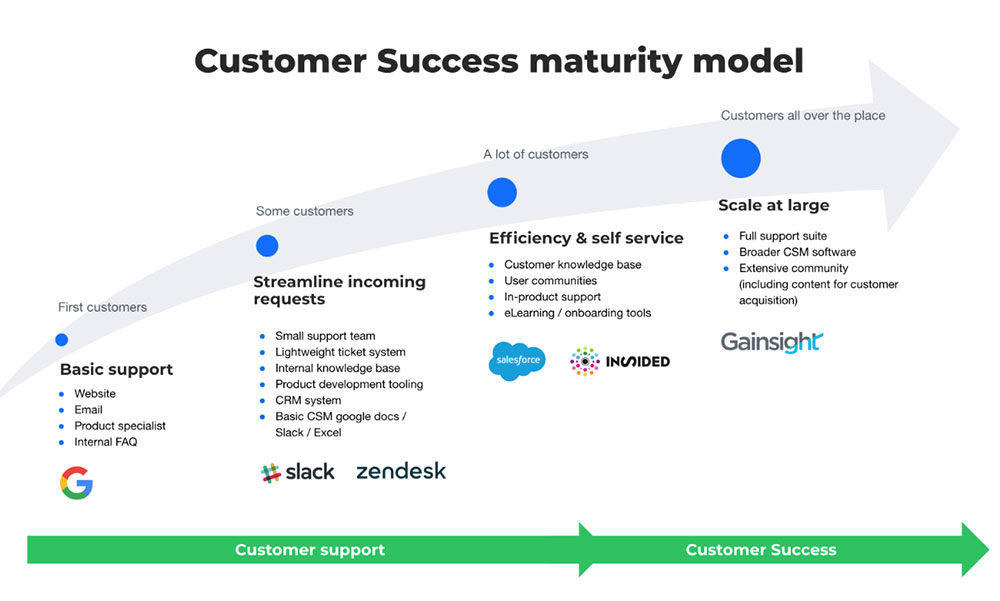Originally published on inSided.com on February 21, 2020.
Are you struggling to know what Customer Success tools and tactics you should be using as your company grows? Look no further. Here we highlight three of the most prominent challenges Customer Success teams are facing in B2B SaaS today and offer up our take on what your tech stack should look like—and how to get the most from it—as your organization evolves.
Recently we’ve been banging on a lot about the Customer Success Maturity Model. We even did a podcast on it with Practical CSM’s Rick Adams that you can listen to here. As a quick recap, it’s a model that allows you to easily pinpoint what stage of growth your SaaS company is at, and what Customer Success software you need at any given stage.
Sounds pretty simple, right? Here it is:

As you can see, the model begins with a young company, first starting out providing basic support to their first customers via email and a simple website. Then, naturally (hopefully) you start to gain more customers. You build out your support team—implement a ticketing system such as Zendesk and perhaps create a small knowledge base of company content.
Then the challenges really begin.
Your company and user base starts to grow rapidly. It quickly becomes apparent that your current Customer Support and Success teams can’t handle the sheer volume of tickets while maintaining the top quality customer experience your users expect and deserve. Now you are looking for a heavy duty CRM like Salesforce, and you may want to invest in a community. Finally, you’re growing rapidly—you might want a bolder CRM such as Gainsight and will no doubt have a full support suite by this stage.
Phew.
Of course, this model didn’t just come out of thin air. To come up with it we took our own experience as a SaaS company (yes, we have battled with all of the issues we are going to cover too!) and combined it with research from speaking to over 30 CSMs in the industry. And, while their challenges—and tooling—varied from company to company, they all had one major hurdle to overcome: Maintaining quality support as their customer base grows rapidly.
In other words, the biggest hurdles for most SaaS companies come at the scaling stage of the Customer Success Maturity Model.
Ok, Ok, we get it. What’s the purpose of this blog?
Well, with this in mind, we are going to pinpoint three specific challenges that come out of the ‘scaling’ stage of company growth. Then we are going to highlight not only what the ideal Customer Success tech stack should look like at this stage, but also how your company can best use this software to overcome its business challenges.
So, here goes—we aren’t promising unicorn status, but you never know, maybe you’ll get some new perspectives on how to tackle everyday issues in SaaS Customer Success!
![]()
1. Challenge: We really lack customer engagement. How do I get my customers interacting more—sharing best practices and talking to each other?
Resolution: In B2B organizations, it can be really tricky to engage your customers, but that’s no reason not to try—we all know how an increase in engagement drives customer retention. That said, there are a whole host of ways of going about it. Plenty of them don’t involve tools in your tech stack. Organize round tables, host or attend events, call, email, send out surveys, create social media groups…the list goes on.
But when it comes to actual software, you might want to invest in a chatbot or live chat function on your site. This can be a great way to encourage engagement and ensure customers get quick responses (usually within under 30 seconds). It would be fair to say, however, that some customers dread talking to an automated bot, and live chats can be a huge drain on your Support resources.
Online communities have the potential to really boost customer engagement. Your customers can easily share best practices in an open secure forum—customers can upvote ideas and easily interact with helpful company-created, or user-generated content. We find that peer-to-peer (P2P) engagement is up to 70% on our B2B communities—20% higher than the industry average.
Suggested tooling: Chatbot, Community, Live Chats.
![]()
2. Challenge: We are answering far too many repeat customer questions. Our Customer Support and Success teams are spending too much time on low-value customer issues. How do I reduce the pressure on them while maintaining a great customer experience?
Resolution: Increasing customer self-service is a sure fire way to reduce pressure on your Customer Support/Success teams and decrease tickets. Here are three ways to help facilitate self-service and make sure customers can easily find the answers they need, when they need them:
- Launch a community: With communities, customers benefit from their peers expertise, share best practices on how to use your product, and get answers to their questions from company created content. We find you can reduce support tickets by up to 50% with an online community.
- Provide an easily maintained knowledge base: Having an up-to-date knowledge base filled with useful help content should be a go-to when trying to increase self-service. What’s more, when you combine a knowledge base with an online community you really have the power to facilitate effective self-service. Not only are customers given answers from your company-created knowledge base, they can benefit from the most helpful user-generated content on your community too.
- Offer In-app support: Having the right content is one thing, but it needs to be easily accessible at all times for your customers. That’s where offering In-app support ensures always have resolutions to their queries at their fingertips.
Suggested tooling: In-app Support, Community + Knowledge base combination.
![]()
3. Challenge: We get a lot of customer feedback and ideas, but it’s all over the place. How do I effectively gather, prioritize and implement all these suggestions?
Resolution: This one is super-simple. Firstly, you need one place where customers submit ideas and give feedback. Social media groups can be used, but you don’t ‘own’ the content, and some customers don’t like being on social channels. Again, communities are an option—allowing customers to submit ideas and vote on them on a secure platform. Integrating your community with a CRM like Gainsight or Salesforce also allows you to then prioritize ideas by customer engagement or ARR. No more question marks over the true business value of customer requests.
Suggested tooling: Community, CRM like Salesforce or Gainsight.
As a final point, it goes without saying that the key to true Customer Success doesn’t just lie in having the right tooling, at the right time. It’s knowing how to leverage that tooling to help you tackle the ever-changing problems as your company grows. Crucially, that includes integrating your Customer Success tools to make sure you have the most efficient tech stack that suits the needs of your company, and your customers.
We are fully aware that Customer Success teams come up against many more challenges in their daily job. And, we aren’t suggesting these resolutions and tools are the answer to all your prayers, but we hope our suggestions have helped. Are you struggling to battle with Customer Success challenges we didn’t mention? We’d love to hear from you—get in touch!
Learn More
Looking create a single destination for your customers to connect, share best practices, provide feedback, and build a stronger relationship with your product? Schedule a demo to learn more.

